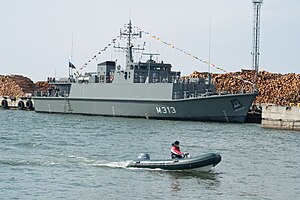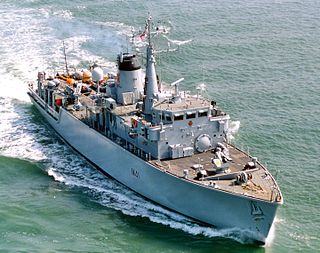
The Hunt class is a class of thirteen mine countermeasure vessels of the Royal Navy. As built, they combined the separate roles of the traditional minesweeper and that of the active minehunter in one hull, but later modifications saw the removal of mine-sweeping equipment. They have a secondary role as offshore patrol vessels.

The Sandown class is a class of fifteen minehunters built primarily for the Royal Navy by Vosper Thornycroft. The Sandown class also serve with the Royal Saudi Navy, the Estonian Navy, and the Ukrainian Navy. The first vessel was commissioned into Royal Navy service on 9 June 1989 and all the British ships are named after coastal towns and cities. They have a secondary role as offshore patrol vessels.

The Commander-in-Chief Fleet (CINCFLEET) was the admiral responsible for the operations of the ships, submarines and aircraft of the British Royal Navy from 1971 until April 2012. The post was subordinate to the First Sea Lord, the professional head of the Naval Service. In its last years, as the Navy shrank, more administrative responsibilities were added.

HMS Bangor is a Sandown-class minehunter commissioned by the Royal Navy in 1999. Designed to hunt naval mines in depths of up to 200 m (660 ft) using the Sonar 2093 Variable Depth Sonar (VDS) meaning that she can conduct mine clearance operations throughout the continental shelf. She is named after the Northern Ireland seaside town of the same name, and the second Royal Navy vessel to bear the name.

The Estonian Navy are the unified naval forces among the Estonian Defence Forces.
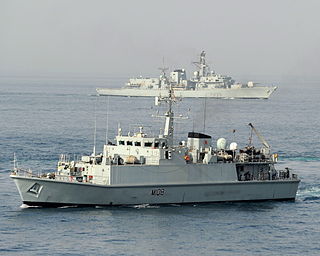
HMS Grimsby was a Sandown-class minehunter of the British Royal Navy, serving from 1999–2022, and the second ship to bear the name.

HMS Pembroke is a Sandown-class minehunter of the Royal Navy. She was the second ship launched of the second batch of the class, which had several improvements over the first five ships built. The ship was posted for three years to the Persian Gulf between 2009 and 2012. Pembroke has since been deployed in international exercises and in historic ordnance detection in home waters. Pembroke was the first of the Royal Navy’s Mine Countermeasures Vessels to be fitted with the Oceanographic Reconnaissance Combat Architecture combat system to replace the previous NAUTIS combat system in early 2020.
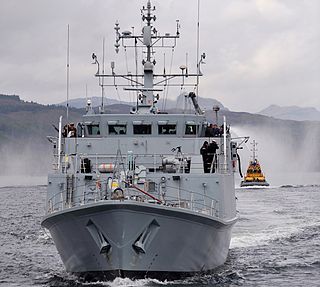
HMS Ramsey was a Sandown-class minehunter of the British Royal Navy. Like other vessels of the Sandown class, Ramsey was built of glass-reinforced plastic and other non-magnetic materials so that her hull does not trigger naval mines as easily as standard warships.

Sublocotenent Ion Ghiculescu (M270) is a Sandown-class minehunter of the Romanian Naval Forces. She was built as HMS Blyth (M111), for the Royal Navy, the eleventh of this class of twelve Single-Role Minehunters (SRMH) ships. She was laid down on 30 May 1999 by Vosper Thornycroft at their Woolston, Southampton shipyard, launched in May 2000 and entered service for the Royal Navy in February 2001. She was the second vessel to carry this name, the first being a Bangor-class minesweeper of the Second World War, wearing pennant number J15. Blyth served in the Middle East as part of the 9th Mine Countermeasures Squadron.

HMS Shoreham was a Sandown-class minehunter of the British Royal Navy. She was the fifth vessel to bear the name. From 2018 to 2021, Shoreham was deployed at UKNSF Bahrain together with three other mine countermeasures ships as part of 9 Mine Countermeasures Squadron on Operation Kipion. In 2022 she was decommissioned and was transferred to Ukraine.

HMSInverness(M102) was a Sandown-class minehunter of the Royal Navy. She was decommissioned by the Royal Navy in 2005, and in 2008 became EMLSakala(M314) of the Estonian Navy.

HMS Brocklesby is a Hunt-class mine countermeasures vessel of the British Royal Navy, her primary purpose is to find and neutralise sea mines using a combination of; Sonar, Mine Clearance Divers and the Seafox remotely operated vehicle (ROV). The class are the largest warships of glass-reinforced plastic (GRP) construction, which gives the vessels a low magnetic signature. In addition to her mine countermeasures activities, Brocklesby acts as an offshore patrol vessel, undertaking coastal patrol and fisheries protection duties.

HMS Atherstone was a Hunt-class mine countermeasures vessel of the Royal Navy, the third ship to bear the name. Built by Vosper Thornycroft shipbuilders at Woolston, Southampton, it was launched on 1 March 1986 by Amy Jarvis, the wife of Pat Jarvis, CB, the Deputy Controller of the Navy at the Ministry of Defence, and commissioned on 17 January 1987. It was the tenth ship of its class.

EMLAdmiral Pitka (A230) was a Beskytteren-class ocean patrol vessel and former flagship of the Estonian Navy, belonging to the Mineships Division. She was named after Estonian Admiral Johan Pitka.

EML Wambola (M311) is a Lindau-class minehunter of the Estonian Navy Mineships Division, formerly the German warship Cuxhaven. The commanding officer of the vessel is Captain Jaanus Antson. The minehunter Wambola is the first vessel of the Estonian Navy Mineships Division and also the first modernized Lindau-class minehunter. A black keel on a silver background with a golden battle-axe is on the coat of arms of the vessel. The battle-axe is a weapon used by the ancient Estonians which also symbolizes their fighting spirit and strength. The ships motto is the Latin "Ad unquem" which is in English "Onto the nail head". The coat of arms was designed by Priit Herodes. In 2000 a cooperation contract was signed between the Pärnu city council and the minehunter Wambola which gave the vessel a right to wear the Pärnu town coat of arms and to introduce the city in all foreign harbors across the world.

The Estonian Mineships Division was the main Estonian Naval Unit and the part of Estonian Navy. The top priority for the Navy is the development of a mine countermeasures capability, as that is also one of the Navy's peacetime responsibilities: during World War I and II more than 80,000 sea mines were laid in the Baltic Sea. Since 1995 a number of mine clearance operations have been carried out in Estonian waters in close co-operation with other navies of the Baltic Sea region in order to find and dispose of ordnance and contribute to safe seagoing. Estonian MCM vessels also participate in NATO naval exercises.
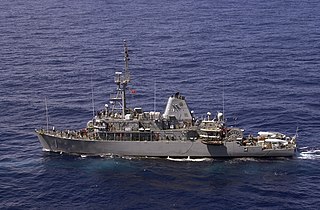
Avenger-class mine countermeasures ships are a class of 14 ships constructed for the United States Navy from 1987 to 1994, designed to clear mines from vital waterways. The ships have the hull designator MCM.
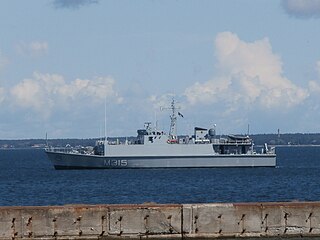
EML Ugandi is a Sandown-class minehunter commissioned by the Estonian Navy in 2009. Ugandi is a former British Royal Navy vessel HMS Bridport built by Woolston Yard of Southampton-based shipbuilders Vosper Thornycroft.
In 1989 the Royal Navy was under the direction of the Navy Department in the UK Ministry of Defence. It had two main commands, CINCFLEET and Naval Home Command.
